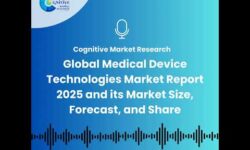
The Wearable Device Ecosystem in 2025: How Wear OS and Apple Watch Are Shaping the Next Era of Connected Health, Productivity, and Lifestyle. Explore Market Growth, Disruptive Technologies, and Strategic Shifts Defining the Future.
- Executive Summary: Key Trends and Market Drivers in 2025
- Market Size and Growth Forecast (2025–2030): Wear OS vs. Apple Watch
- Competitive Landscape: Major Players and Ecosystem Alliances
- Technology Innovations: Sensors, AI, and Health Monitoring
- Platform Evolution: Wear OS, watchOS, and Cross-Platform Integration
- Consumer Adoption: Demographics, Use Cases, and Regional Insights
- Regulatory and Privacy Considerations in Wearable Devices
- Supply Chain and Manufacturing Trends
- Strategic Partnerships and Developer Ecosystems
- Future Outlook: Opportunities, Challenges, and Disruptive Scenarios
- Sources & References
Executive Summary: Key Trends and Market Drivers in 2025
The wearable device ecosystem, anchored by platforms such as Wear OS and Apple Watch, is poised for significant evolution in 2025. The sector is characterized by rapid technological advancements, expanding health and wellness functionalities, and deepening integration with broader digital ecosystems. Key trends and market drivers shaping this landscape include platform innovation, cross-device interoperability, and a growing emphasis on health monitoring and data privacy.
Platform Leadership and Expansion: Apple Inc. continues to dominate the smartwatch segment with its Apple Watch, leveraging a tightly integrated hardware-software approach and a robust developer ecosystem. The Apple Watch remains a central hub for health, fitness, and communication, with ongoing enhancements in sensors and software capabilities. Meanwhile, Google LLC is accelerating the evolution of Wear OS, its Android-based wearable platform, through strategic partnerships with leading device manufacturers such as Samsung Electronics and Mobvoi. The collaboration between Google and Samsung, particularly since the unification of Tizen and Wear OS, has resulted in improved performance, battery life, and app availability across a growing range of devices.
Health and Wellness as Core Value Propositions: The integration of advanced health monitoring features is a primary driver of consumer adoption. Both Apple and Google are investing in new sensor technologies and software algorithms to enable continuous tracking of vital signs, sleep, and activity. Apple’s focus on medical-grade features, such as ECG and blood oxygen monitoring, is complemented by Google’s push to integrate Fitbit’s health expertise into Wear OS devices. This trend is expected to intensify in 2025, with regulatory approvals and partnerships with healthcare providers expanding the clinical relevance of wearables.
Interoperability and Ecosystem Integration: Seamless connectivity with smartphones, smart home devices, and cloud services is increasingly important. Apple’s ecosystem advantage is reinforced by features like Handoff, Family Setup, and integration with iOS and HomeKit. Google is leveraging its Android and Google Assistant platforms to create a unified experience across devices, including smartwatches, earbuds, and fitness trackers. Samsung, as both a hardware and software partner, is instrumental in driving cross-device experiences within the Wear OS ecosystem.
Outlook: The wearable device market in 2025 is expected to see continued growth, driven by innovation in health features, improved battery life, and expanding app ecosystems. Privacy and data security will remain critical, with both Apple and Google emphasizing user control and transparency. As wearables become more central to personal health and digital lifestyles, the competitive landscape will be shaped by the ability of leading platforms to deliver meaningful, secure, and integrated user experiences.
Market Size and Growth Forecast (2025–2030): Wear OS vs. Apple Watch
The global wearable device ecosystem, particularly the segments dominated by Apple Inc. (Apple Watch) and Google LLC (Wear OS), is poised for robust growth from 2025 through 2030. As of early 2025, the smartwatch market continues to be led by Apple Watch, which has maintained a significant market share since its introduction, leveraging deep integration with the iOS ecosystem and a strong focus on health and fitness features. Apple Inc. has consistently expanded its Apple Watch lineup, introducing new health sensors, improved battery life, and enhanced connectivity, which have contributed to sustained consumer demand.
Wear OS, developed by Google LLC, has seen renewed momentum following strategic partnerships with major device manufacturers such as Samsung Electronics Co., Ltd. and Mobvoi Information Technology Company Limited. The collaboration between Google and Samsung, particularly since the launch of the unified Wear OS platform, has resulted in a broader range of devices and improved user experiences, helping Wear OS gain traction in markets where Android smartphones are prevalent.
In 2025, the global smartwatch market is estimated to ship over 200 million units, with Apple Watch accounting for a substantial portion of these shipments. Apple Inc. continues to dominate in North America, Western Europe, and parts of Asia-Pacific, while Wear OS devices, supported by a diverse array of hardware partners, are expanding their presence in emerging markets and among Android users. Samsung Electronics Co., Ltd. remains a key player in the Wear OS ecosystem, with its Galaxy Watch series consistently ranking among the top-selling smartwatches worldwide.
Looking ahead to 2030, the wearable device ecosystem is expected to experience compound annual growth driven by advancements in health monitoring, integration with smart home and IoT devices, and the proliferation of 5G connectivity. Both Apple Inc. and Google LLC are investing heavily in research and development to enhance device capabilities, including non-invasive health sensors and improved AI-driven features. The competitive landscape is likely to intensify as new entrants and established players introduce innovative form factors and services.
- Apple Watch: Expected to maintain leadership in premium segments, leveraging ecosystem lock-in and continuous feature expansion.
- Wear OS: Projected to grow faster in unit shipments, especially in price-sensitive and Android-dominant regions, supported by partners like Samsung Electronics Co., Ltd. and Mobvoi Information Technology Company Limited.
By 2030, the combined market for Wear OS and Apple Watch is anticipated to represent the majority of global smartwatch shipments, with both ecosystems driving innovation and shaping the future of wearable technology.
Competitive Landscape: Major Players and Ecosystem Alliances
The competitive landscape of the wearable device ecosystem in 2025 is defined by the dominance of two major platforms: Apple Inc. with its Apple Watch and Google LLC with Wear OS. These platforms anchor extensive hardware and software ecosystems, shaping the direction of innovation, partnerships, and user engagement in the sector.
Apple continues to lead the global smartwatch market, leveraging its tightly integrated hardware-software approach. The Apple Watch, now in its tenth generation, benefits from seamless connectivity with the broader Apple ecosystem, including iPhone, AirPods, and HealthKit. Apple’s proprietary silicon, advanced health sensors, and focus on privacy and security reinforce its premium positioning. The company’s alliances with health institutions and fitness brands further expand its reach, as seen in ongoing collaborations with major healthcare providers and fitness platforms. Apple’s App Store for watchOS remains a critical channel for third-party developers, fostering a robust ecosystem of health, productivity, and lifestyle applications.
Google’s Wear OS, meanwhile, has solidified its position as the leading open platform for non-Apple smartwatches. Following the integration of Fitbit (acquired in 2021) and the launch of the Pixel Watch line, Google has deepened its partnerships with leading device manufacturers such as Samsung Electronics, Mobvoi, and Fossil Group. Samsung, in particular, has played a pivotal role, co-developing Wear OS 4 and integrating it into its Galaxy Watch series, which are among the most popular Android-compatible wearables globally. Google’s ecosystem strategy emphasizes interoperability, with Wear OS devices supporting a wide range of Android smartphones and integrating with Google services such as Assistant, Maps, and Wallet.
Ecosystem alliances are increasingly important as wearables expand into health, payments, and smart home control. Apple’s HealthKit and ResearchKit frameworks enable partnerships with medical institutions, while Google’s Health Connect API facilitates data sharing across health and fitness apps. Both companies are investing in cross-platform compatibility, with Apple introducing limited support for third-party health devices and Google enhancing Wear OS’s integration with iOS.
Looking ahead, the competitive landscape is expected to intensify as both Apple and Google pursue deeper integration with AI-driven health insights, advanced biometric sensors, and expanded developer tools. Strategic alliances with healthcare providers, insurance companies, and fitness brands will likely accelerate, as wearables become central to preventive health and personalized wellness. The ongoing rivalry between Apple and Google, supported by their respective hardware partners and developer communities, will continue to shape the evolution of the wearable device ecosystem through 2025 and beyond.
Technology Innovations: Sensors, AI, and Health Monitoring
The wearable device ecosystem, particularly around platforms such as Wear OS and Apple Watch, is experiencing rapid technological innovation in 2025, driven by advancements in sensor technology, artificial intelligence (AI), and health monitoring capabilities. These developments are reshaping how consumers interact with their devices and manage their health.
Sensor Technology: Both Apple Inc. and Google LLC (developer of Wear OS) have significantly enhanced the sensor arrays in their latest smartwatches. The Apple Watch Series 10, expected in late 2025, is rumored to include next-generation optical sensors for more accurate heart rate, blood oxygen, and temperature monitoring. Apple’s continued investment in custom silicon, such as the S-series chips, enables more efficient sensor data processing and longer battery life. Meanwhile, Wear OS partners like Samsung Electronics and Mobvoi are integrating multi-modal sensors, including bioimpedance and advanced photoplethysmography, to expand the range of measurable health metrics.
AI and Data Analytics: AI is central to the evolution of wearable platforms. Apple’s on-device machine learning models now provide real-time arrhythmia detection, sleep stage analysis, and personalized health insights, all processed securely on the device. Google’s Wear OS leverages its AI expertise to offer proactive health nudges, stress tracking, and context-aware suggestions, integrating with Google Health Connect for seamless data sharing across devices. Samsung’s Galaxy Watch line, running Wear OS, incorporates AI-driven coaching and fall detection, reflecting a broader industry trend toward predictive and preventative health features.
Health Monitoring and Regulatory Progress: The ecosystem is also marked by a push toward medical-grade health monitoring. Apple continues to collaborate with regulatory bodies to expand the Apple Watch’s FDA-cleared features, such as ECG and irregular rhythm notifications. In 2025, both Apple and Google are reportedly exploring non-invasive glucose monitoring, a long-sought breakthrough for diabetes management. Samsung, a key Wear OS partner, is piloting blood pressure and sleep apnea detection features in select markets, pending regulatory approval.
- Apple’s HealthKit and ResearchKit frameworks are enabling third-party developers and research institutions to build advanced health applications, further enriching the ecosystem.
- Wear OS’s open platform approach allows a diverse range of hardware partners, including Fossil Group and Suunto, to innovate with specialized sensors and form factors.
Looking ahead, the wearable device ecosystem is expected to see deeper integration with healthcare providers, more robust privacy protections, and the introduction of new sensor modalities (such as hydration and respiratory rate monitoring). As AI models become more sophisticated and regulatory pathways mature, wearables are poised to play an increasingly central role in personal and preventive healthcare.
Platform Evolution: Wear OS, watchOS, and Cross-Platform Integration
The wearable device ecosystem, particularly around Apple Inc.’s watchOS and Google LLC’s Wear OS, is undergoing significant transformation in 2025, driven by platform evolution and increasing cross-platform integration. These two operating systems dominate the global smartwatch market, shaping both user experience and developer priorities.
In 2025, Apple Inc. continues to lead with watchOS, which powers the Apple Watch series. The latest iterations of watchOS emphasize deeper health monitoring, expanded third-party app capabilities, and tighter integration with the broader Apple ecosystem, including iPhone, iPad, and Mac. Apple’s focus on privacy, seamless device handoff, and ecosystem lock-in remains central, with features like Family Setup and enhanced fitness tracking further differentiating its platform.
Meanwhile, Google LLC’s Wear OS has seen renewed momentum following its strategic partnership with Samsung Electronics Co., Ltd., which began integrating Wear OS into its Galaxy Watch lineup in recent years. This collaboration has resulted in a unified platform that combines Google’s software strengths with Samsung’s hardware and health-tracking expertise. In 2025, Wear OS is characterized by improved battery life, smoother performance, and a growing library of apps, as well as enhanced compatibility with Android smartphones and select cross-platform features.
Cross-platform integration is a defining trend. Both Apple and Google are expanding interoperability, albeit within their respective ecosystems. Apple’s watchOS leverages iCloud and Continuity to allow users to start tasks on one device and finish on another, while Wear OS benefits from Google’s cloud services and integration with Android Auto, Google Assistant, and Google Fit. Samsung, as a major Wear OS partner, also enables cross-device experiences with its SmartThings platform, connecting wearables to smart home devices.
Looking ahead, the wearable ecosystem is expected to see further convergence with health, fitness, and smart home platforms. Both Apple and Google are investing in AI-driven health insights and personalized recommendations, while also opening their platforms to third-party developers for new use cases. The competitive landscape is likely to intensify as both companies push for greater device interoperability, improved developer tools, and expanded global reach.
- Apple Inc.: Developer of watchOS and Apple Watch hardware, leading in ecosystem integration and health features.
- Google LLC: Developer of Wear OS, driving cross-platform integration and Android compatibility.
- Samsung Electronics Co., Ltd.: Key Wear OS partner, innovating in hardware and health tracking.
Consumer Adoption: Demographics, Use Cases, and Regional Insights
The wearable device ecosystem, particularly platforms such as Wear OS by Google LLC and Apple Watch by Apple Inc., continues to experience robust consumer adoption in 2025. Demographic trends, evolving use cases, and regional dynamics are shaping the trajectory of this sector.
Demographics: The user base for wearables is diversifying. While early adoption skewed toward tech-savvy younger adults, recent years have seen increased uptake among older demographics, driven by health monitoring features such as ECG, fall detection, and medication reminders. Both Apple Inc. and Google LLC have enhanced accessibility and health features to appeal to seniors and those managing chronic conditions. Additionally, the integration of family setup and parental controls is attracting younger users and families, broadening the ecosystem’s reach.
Use Cases: Health and fitness remain the primary drivers of wearable adoption. The Apple Watch, for example, offers advanced health metrics, including blood oxygen monitoring and irregular heart rhythm notifications, while Wear OS devices leverage partnerships with fitness and health app providers. Beyond health, contactless payments, smart home integration, and productivity tools are gaining traction. The expansion of third-party app ecosystems on both platforms is enabling new use cases, such as travel, navigation, and even workplace safety monitoring. Notably, the integration of AI-powered features—like personalized coaching and proactive health alerts—has become a key differentiator in 2025.
Regional Insights: North America and Western Europe remain the largest markets for wearables, with high penetration rates and strong brand loyalty toward Apple Inc. and Google LLC products. In Asia-Pacific, adoption is accelerating, particularly in urban centers, driven by rising health awareness and increasing smartphone penetration. Localized features, such as language support and region-specific health metrics, are being prioritized to cater to diverse populations. In emerging markets, affordability and compatibility with Android devices are boosting the appeal of Wear OS-powered watches, often manufactured by partners such as Samsung Electronics Co., Ltd. and Mobvoi Information Technology Company Limited.
Outlook: Looking ahead, the wearable ecosystem is expected to deepen its integration with healthcare providers and insurance companies, further driving adoption across age groups and regions. The convergence of health, productivity, and lifestyle applications, coupled with ongoing hardware and software innovation from leading players, positions wearables as a central component of the connected consumer experience through 2025 and beyond.
Regulatory and Privacy Considerations in Wearable Devices
The regulatory and privacy landscape for wearable devices, particularly those operating within the Wear OS and Apple Watch ecosystems, is rapidly evolving in 2025. As these devices increasingly collect sensitive health, biometric, and location data, regulatory scrutiny has intensified globally. Both Apple Inc. and Google LLC (developer of Wear OS) have responded by enhancing privacy features and compliance mechanisms to address new and forthcoming regulations.
In the United States, the Health Insurance Portability and Accountability Act (HIPAA) and the California Consumer Privacy Act (CCPA) continue to influence how wearable data is managed, especially as more health-related features are integrated into smartwatches. Apple Inc. has emphasized its commitment to privacy, implementing on-device processing for sensitive health metrics and providing users with granular control over data sharing. The company’s Health app, central to the Apple Watch experience, encrypts health data both in transit and at rest, and users can selectively share information with healthcare providers or third-party apps.
Similarly, Google LLC has updated Wear OS to include more robust privacy dashboards and clearer consent flows, reflecting the requirements of the European Union’s General Data Protection Regulation (GDPR) and anticipated updates to the ePrivacy Regulation. Google’s acquisition of Fitbit has further heightened regulatory attention, prompting the company to commit to strict data separation between health data and advertising services, as outlined in its public statements to the European Commission.
In Asia-Pacific, countries such as Japan and South Korea are introducing or updating privacy laws to address the proliferation of wearable devices. Both Apple Inc. and Google LLC have expanded their compliance teams and localized privacy features to meet these regional requirements, including enhanced user consent and data localization options.
Looking ahead, the wearable device ecosystem is expected to face increasing regulatory complexity as governments introduce new frameworks for artificial intelligence, biometric data, and cross-border data transfers. Industry leaders are proactively engaging with regulators and industry bodies to shape standards and best practices. The outlook for 2025 and beyond suggests that privacy and regulatory compliance will remain central to product development and user trust, with ongoing updates to operating systems and device features to address emerging legal and ethical challenges.
Supply Chain and Manufacturing Trends
The supply chain and manufacturing landscape for wearable devices, particularly those operating on Wear OS and Apple Watch platforms, is undergoing significant transformation in 2025. The sector is characterized by increasing vertical integration, regional diversification, and a focus on sustainability and advanced component sourcing.
Apple Inc. continues to dominate the smartwatch market with its Apple Watch, leveraging a tightly controlled supply chain. Apple’s longstanding partnerships with contract manufacturers such as Hon Hai Precision Industry Co., Ltd. (Foxconn) and Compal Electronics remain central to its strategy. In 2025, Apple is further localizing production, expanding assembly operations in India and Vietnam to mitigate geopolitical risks and supply chain disruptions. This shift is also driven by the need to comply with evolving trade regulations and to reduce reliance on single-region manufacturing hubs.
On the Wear OS side, Google LLC continues to develop the platform, while hardware is produced by a diverse set of partners, including Samsung Electronics, Mobvoi, and Fossil Group. Samsung, in particular, has vertically integrated much of its supply chain, manufacturing key components such as displays, chipsets, and batteries in-house. This integration allows for greater control over quality and innovation, as seen in the latest Galaxy Watch models.
Component sourcing is increasingly focused on advanced materials and miniaturization. Suppliers like Taiwan Semiconductor Manufacturing Company (TSMC) and Qualcomm Incorporated are pivotal, providing next-generation processors that enable improved battery life and enhanced health monitoring features. The adoption of new sensor technologies, such as non-invasive glucose monitoring and advanced bioimpedance sensors, is driving collaboration between device makers and specialized component suppliers.
Sustainability is a growing priority. Both Apple and Samsung have announced initiatives to increase the use of recycled materials in device casings and bands, and to reduce carbon emissions across their supply chains. Apple, for example, is working toward carbon-neutral manufacturing for all its products by 2030, with progress visible in its 2025 supply chain operations.
Looking ahead, the wearable device ecosystem is expected to see further regional diversification, with more assembly and component manufacturing shifting to Southeast Asia and India. The integration of AI-driven manufacturing processes and increased automation is anticipated to enhance efficiency and flexibility, supporting rapid product iteration and customization. As the market matures, supply chain resilience and sustainability will remain central themes shaping the strategies of leading ecosystem players.
Strategic Partnerships and Developer Ecosystems
The wearable device ecosystem, particularly around platforms like Wear OS and Apple Watch, is increasingly defined by strategic partnerships and robust developer ecosystems. As of 2025, these collaborations are central to driving innovation, expanding functionality, and ensuring seamless integration with broader digital services.
Apple Inc. continues to leverage its tightly integrated hardware-software approach, fostering a vibrant developer community through its Apple Inc. Developer Program. The Apple Watch ecosystem benefits from deep partnerships with health institutions, fitness brands, and enterprise solution providers. For example, Apple’s ongoing collaborations with healthcare organizations enable advanced health monitoring features, such as ECG and blood oxygen tracking, to be integrated into clinical workflows. The company’s HealthKit and ResearchKit frameworks further encourage third-party developers to create health and wellness applications, reinforcing Apple Watch’s position as a leading health-focused wearable.
On the other hand, Google LLC has revitalized its Wear OS platform through strategic alliances with major device manufacturers and service providers. The 2021 partnership with Samsung Electronics Co., Ltd.—which merged Tizen with Wear OS—continues to bear fruit in 2025, resulting in a unified platform that powers devices like the Galaxy Watch series. This collaboration has attracted a broader developer base, as the combined market share and technical capabilities offer greater incentives for app creation and optimization. Google’s Play Store and developer tools provide a gateway for third-party apps, while partnerships with fitness, payment, and productivity service providers expand the platform’s utility.
Both ecosystems are increasingly open to cross-platform integrations. For instance, Apple’s support for third-party fitness equipment and Google’s compatibility with a range of Android and iOS devices highlight a trend toward interoperability. Strategic partnerships with payment networks, such as Visa Inc. and Mastercard Incorporated, have enabled contactless payments on both platforms, further embedding wearables into daily life.
Looking ahead, the developer ecosystems for both Wear OS and Apple Watch are expected to grow, driven by advancements in AI, health monitoring, and IoT integration. Strategic partnerships with automotive, smart home, and enterprise technology providers are likely to deepen, as wearables become central nodes in connected environments. The focus on privacy, security, and regulatory compliance will also shape future collaborations, ensuring that the wearable device ecosystem remains robust and trusted.
Future Outlook: Opportunities, Challenges, and Disruptive Scenarios
The wearable device ecosystem, particularly platforms like Wear OS and Apple Watch, is poised for significant evolution in 2025 and the following years. The sector is characterized by rapid technological advancements, increasing integration with health and wellness services, and expanding partnerships across industries. As of 2025, the global installed base of smartwatches and wearables continues to grow, driven by consumer demand for health monitoring, convenience, and seamless connectivity.
Opportunities in the ecosystem are substantial. Apple Inc. remains the dominant player, with the Apple Watch leading in market share due to its robust integration with iOS, advanced health sensors, and a growing suite of health-related features. The company’s ongoing investments in health research and partnerships with medical institutions position the Apple Watch as a potential hub for preventive healthcare and chronic disease management. Meanwhile, Google LLC continues to expand the Wear OS platform, leveraging its acquisition of Fitbit and partnerships with leading device manufacturers such as Samsung and Fossil. The open nature of Wear OS allows for a diverse range of hardware options and deeper integration with Android devices, fostering innovation in form factors and use cases.
The convergence of wearables with artificial intelligence and cloud services is expected to unlock new functionalities, such as real-time health analytics, personalized coaching, and proactive health alerts. Both Apple and Google are investing in on-device machine learning to enhance privacy and responsiveness. Additionally, the integration of wearables with smart home and automotive ecosystems is anticipated to create new user experiences and business models, particularly as Samsung Electronics and other partners expand their connected device portfolios.
However, challenges persist. Data privacy and security remain paramount concerns, especially as wearables collect increasingly sensitive health and biometric data. Regulatory scrutiny is intensifying, with authorities in the US, EU, and Asia demanding greater transparency and user control. Interoperability between platforms (e.g., iOS and Android) and across device brands is another hurdle, potentially limiting user choice and ecosystem growth. Battery life and miniaturization of sensors also continue to constrain device capabilities, though ongoing R&D aims to address these issues.
Looking ahead, disruptive scenarios could emerge from several fronts. Advances in non-invasive health monitoring (e.g., blood glucose tracking) could transform wearables into essential medical devices, attracting new entrants and regulatory frameworks. The rise of augmented reality (AR) wearables, championed by companies like Apple Inc. and Samsung Electronics, may blur the lines between smartwatches, fitness bands, and smart glasses, reshaping the competitive landscape. Furthermore, strategic alliances between tech giants, healthcare providers, and insurers could redefine value propositions and accelerate adoption in enterprise and clinical settings.
Sources & References
- Apple Inc.
- Google LLC
- Mobvoi
- Suunto
- Hon Hai Precision Industry Co., Ltd. (Foxconn)
- Compal Electronics
- Qualcomm Incorporated
- Apple Inc.
- Google LLC
- Visa Inc.

This post Wearable Device Ecosystem 2025–2030: Explosive Growth & Innovation in Wear OS and Apple Watch appeared first on Macho Levante.

A former fintech consultant turned blockchain advocate, Bernard S. Mills brings over 15 years of financial industry experience to his crypto commentary. Known for his deep dives into decentralized finance (DeFi) protocols and market strategy, Bernard combines technical insights with real-world applications. When he’s not dissecting tokenomics, he’s mentoring startups in the Web3 space.








